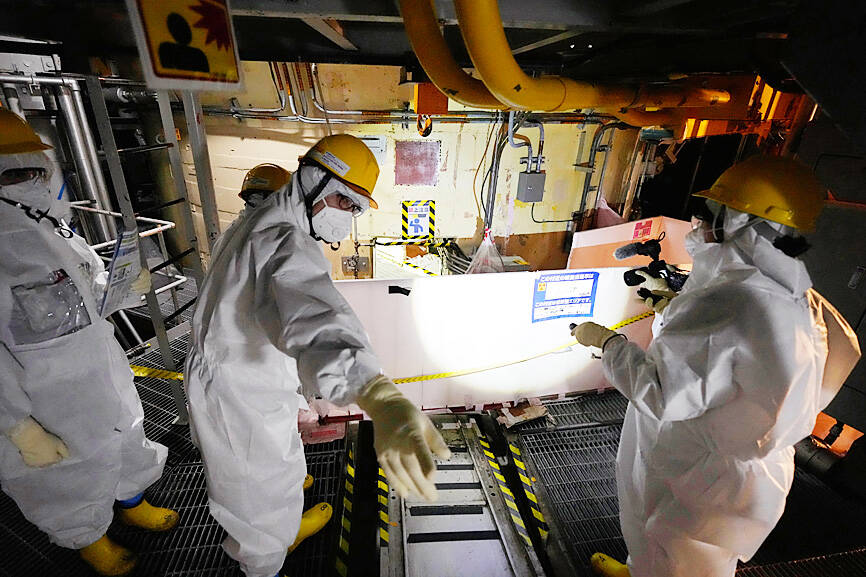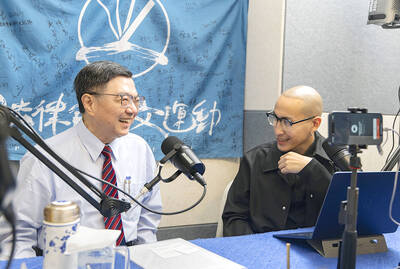Japanese engineers yesterday began a difficult operation to remove a second sample of radioactive debris from inside the stricken Fukushima Dai-ichi nuclear power plant.
About 880 tonnes of hazardous material are inside the site after a catastrophic tsunami caused by a magnitude 9.0 earthquake triggered one of history’s worst nuclear accidents in 2011.
Removing the debris is seen as the most daunting challenge in a decades-long decommissioning project because of the dangerously high radiation levels.

Photo: AP
“At 10:03am, the second trial extraction operation was started,” operator Tokyo Electric Power Co (TEPCO) said in a statement.
The second removal comes after TEPCO completed the first trial removal operation using a specially developed extendible device in November last year.
The sample weighing just below 0.7g — equivalent to about one raisin — was delivered to a research laboratory near Tokyo for analysis, but TEPCO needs more data to examine methods for full-scale debris extractions.
The company in December last year said that it was “upgrading” the telescopic device used for the first experiment by attaching a new camera to its tip.
Three of Fukushima Dai-ichi’s six reactors went into meltdown in 2011 after the huge tsunami swamped the facility.
Robots last month began moving sandbags that were used to absorb radiation-contaminated water on underground floors of two buildings at the site.
Japan in 2023 began releasing into the Pacific Ocean some of the 540 Olympic swimming pools of treated wastewater, which has been endorsed by the International Atomic Energy Agency.
China banned Japanese seafood imports as a result, and Russia later followed suit.
China earlier this month said that it found no abnormalities in seawater and marine life samples that it independently collected near the nuclear power plant in February, but Beijing indicated that more tests would be needed before it lifts the ban.

Taiwanese Olympic badminton men’s doubles gold medalist Wang Chi-lin (王齊麟) and his new partner, Chiu Hsiang-chieh (邱相榤), clinched the men’s doubles title at the Yonex Taipei Open yesterday, becoming the second Taiwanese team to win a title in the tournament. Ranked 19th in the world, the Taiwanese duo defeated Kang Min-hyuk and Ki Dong-ju of South Korea 21-18, 21-15 in a pulsating 43-minute final to clinch their first doubles title after teaming up last year. Wang, the men’s doubles gold medalist at the 2020 and 2024 Olympics, partnered with Chiu in August last year after the retirement of his teammate Lee Yang

FALSE DOCUMENTS? Actor William Liao said he was ‘voluntarily cooperating’ with police after a suspect was accused of helping to produce false medical certificates Police yesterday questioned at least six entertainers amid allegations of evasion of compulsory military service, with Lee Chuan (李銓), a member of boy band Choc7 (超克7), and actor Daniel Chen (陳大天) among those summoned. The New Taipei City District Prosecutors’ Office in January launched an investigation into a group that was allegedly helping men dodge compulsory military service using falsified medical documents. Actor Darren Wang (王大陸) has been accused of being one of the group’s clients. As the investigation expanded, investigators at New Taipei City’s Yonghe Precinct said that other entertainers commissioned the group to obtain false documents. The main suspect, a man surnamed

DEMOGRAPHICS: Robotics is the most promising answer to looming labor woes, the long-term care system and national contingency response, an official said Taiwan is to launch a five-year plan to boost the robotics industry in a bid to address labor shortages stemming from a declining and aging population, the Executive Yuan said yesterday. The government approved the initiative, dubbed the Smart Robotics Industry Promotion Plan, via executive order, senior officials told a post-Cabinet meeting news conference in Taipei. Taiwan’s population decline would strain the economy and the nation’s ability to care for vulnerable and elderly people, said Peter Hong (洪樂文), who heads the National Science and Technology Council’s (NSTC) Department of Engineering and Technologies. Projections show that the proportion of Taiwanese 65 or older would

The government is considering polices to increase rental subsidies for people living in social housing who get married and have children, Premier Cho Jung-tai (卓榮泰) said yesterday. During an interview with the Plain Law Movement (法律白話文) podcast, Cho said that housing prices cannot be brought down overnight without affecting banks and mortgages. Therefore, the government is focusing on providing more aid for young people by taking 3 to 5 percent of urban renewal projects and zone expropriations and using that land for social housing, he said. Single people living in social housing who get married and become parents could obtain 50 percent more